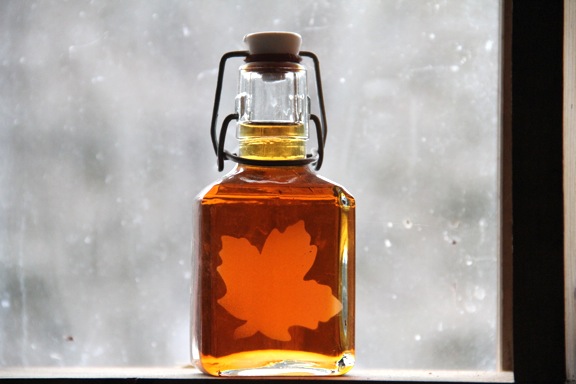SAVOR THE SEASON: Old-timer tells of making maple syrup in the 19th century

Maple syrup in a glass jar sits on a shelf in the sugarhouse at Cornell University’s Uihlein Maple Research Forest field station on Bear Cub Lane, Lake Placid. (News photo — Andy Flynn)
(The following letter was found in the Lake Placid News archives from the April 17, 1931 issue.)
M. S. Wallace, out of his 60 years of experience as a maker of maple sugar and syrup, gives a resume of his memories of the maple sugar industry. The following is a letter recently received from Mr. Wallace by the St. Lawrence Plaindealer.
Mr. Editor:
As the sugar season is again near at hand, I am inclined to reminisce a little on the many changes and improvements in the making of maple sugar and syrup since I can remember over 60 years in the business.
The first I can remember was of being in the sugar woods as a little boy of 8 or 9 years old on a load of sap buckets drawn by an ox team and my older brothers and the hired man scattering the buckets. They always used an ox team to break out the roads as oxen were much better than horses in the deep snow.
Then I remember going round with the men and hanging up the buckets on a nail driven into the side of the trees, as they tapped them. The buckets, gathering tanks and pails were all of wood in those days.
The sap troughs which had been used before had just been replaced with buckets. The sap troughs were made mostly of basswood cut in about 2-foot lengths from trees about 8 inches in diameter, split in halves and hollowed out in the center and seared over with fire to keep them from absorbing the sap, and after the season was over, they were turned over at the side of the tree and left for another year without washing.
The trees were tapped by a man with a sharp axe who made two slanting cuts in at the lower side to conduct the sap as it came from the tree into the trough.
This soon ruined the trees so when I first remember they were using a one and one-half-inch auger, but that has since been reduced to one-half inch, since the invention of the iron spout, and we find we get more sap than in the old way.
The boiling was done in a large iron kettle in the open woods. The kettle was hung on the short end of a long pole fastened to a small tree called a lug pole so that it could be swung on or off the fire.
My job was to stay by the kettle , keep up the fire and skim out the cinders or anything that fell in, while the men were gathering the sap. All things considered, we made a pretty fair grade of sugar, and some people who have been away for many years think now we out in white sugar, it is so much whiter than it used to be.
When my father had a large sugar house built on the side of a small hill in the woods so they could run the sap from the gathering tank to the storage tank, house the buckets and make a place for the wood, and when he bought a Vermont evaporator and had a brick arch made, it was a great improvement over the old way, as we didn’t have to boil the sap so long. They claimed that would boil a pail of sap a minute with sap running in at the front end with syrup passing out at the back end, but this was not literally true.
My father was a cooper and in the winter made all the store tanks, tubs and pails that were used, as well as for many of the neighbors.
Before the Civil War, there was not much white sugar used in this north country and the people had to depend on the sugar maple for the most of their sweetening. My mother only kept a pound or two of white sugar in the house, for company purposes, and sometimes we children would get a little for being extra good. It came in little cubes about three-fourths of an inch on the side. We would do almost anything to get a piece of white sugar which came pretty near being my undoing, but I must leave that for some other time.
The wooden utensils have long since been replaced by tin or galvanized iron in all the best sugar camps. The old evaporators have been replaced by still better ones. We used to make several hundred pounds, enough to last a year.
It takes about 12 quarts of sap to make a pound of sugar. Those were the good times we used to have when sugaring off time came, as we gathered wax or scraped the kettle. But times have changed. The old folks have all passed on.
M. S. Wallace






